
Lee Oscar Lawrie was an American architectural sculptor and an important figure in the American sculpture scene preceding World War II. Over his long career of more than 300 commissions Lawrie's style evolved through Modern Gothic, to Beaux-Arts, Classicism, and, finally, into Moderne or Art Deco.

The Albert Memorial, directly north of the Royal Albert Hall in Kensington Gardens, London, was commissioned by Queen Victoria in memory of her beloved husband Prince Albert, who died in 1861. Designed by Sir George Gilbert Scott in the Gothic Revival style, it takes the form of an ornate canopy or pavilion 176 feet (54 m) tall, in the style of a Gothic ciborium over the high altar of a church, sheltering a statue of the prince facing south. It took over ten years to complete, the £120,000 cost met by public subscription.

Sir William Hamo Thornycroft was an English sculptor, responsible for some of London's best-known statues, including the statue of Oliver Cromwell outside the Palace of Westminster. He was a keen student of classical sculpture and was one of the youngest artists to be elected to the Royal Academy, in 1882, the same year the bronze cast of Teucer was purchased for the British nation under the auspices of the Chantrey Bequest.
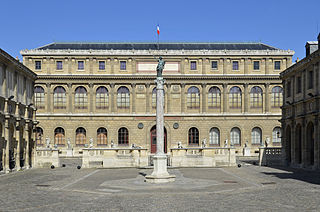
The Beaux-Arts de Paris, formally the École nationale supérieure des beaux-arts, is a French grande école whose primary mission is to provide high-level fine arts education and training. The art school, which is part of the Paris Sciences et Lettres University, is located on two sites: Saint-Germain-des-Prés in Paris, and Saint-Ouen.

Alexander Stirling Calder was an American sculptor and teacher. He was the son of sculptor Alexander Milne Calder and the father of sculptor Alexander (Sandy) Calder. His best-known works are George Washington as President on the Washington Square Arch in New York City, the Swann Memorial Fountain in Philadelphia, and the Leif Eriksson Memorial in Reykjavík, Iceland.
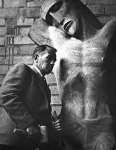
Albert Stewart was an American sculptor.
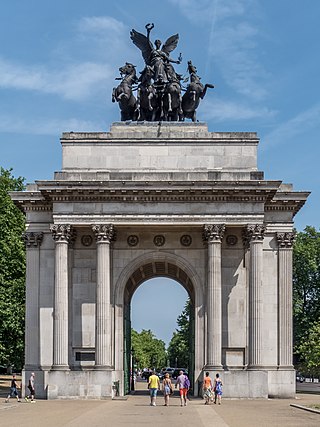
The Wellington Arch, also known as the Constitution Arch or (originally) as the Green Park Arch, is a Grade I-listed triumphal arch by Decimus Burton that forms a centrepiece of Hyde Park Corner in central London, between the corner where Hyde Park meets Green Park. The Arch stands on a large green-space traffic island with crossings for pedestrian access. From its construction (1826–1830) the arch stood in a nearby location, slightly to the east, directly across from Burton's Ionic screen entrance to Hyde Park; it was moved a short distance to its current site at the top of the Constitution Hill road in 1882–1883. The triumphal arch originally supported a colossal equestrian statue of the 1st Duke of Wellington by the sculptor Matthew Cotes Wyatt, acquiring its name as a result. Peace descending on the Quadriga of War by sculptor Adrian Jones, a bronze of the Goddess of Victory Nike riding a quadriga, has surmounted the arch since 1912.
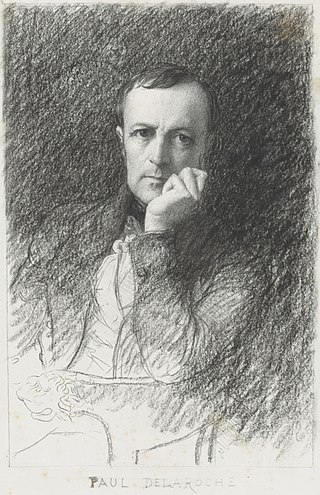
Hippolyte-Paul Delaroche was a French painter who achieved his greater successes painting historical scenes. He became famous in Europe for his melodramatic depictions that often portrayed subjects from English and French history. The emotions emphasised in Delaroche's paintings appeal to Romanticism while the detail of his work along with the deglorified portrayal of historic figures follow the trends of Academicism and Neoclassicism. Delaroche aimed to depict his subjects and history with pragmatic realism. He did not consider popular ideals and norms in his creations, but rather painted all his subjects in the same light whether they were historical figures like Marie-Antoinette, figures of Christianity, or people of his time like Napoleon Bonaparte. Delaroche was a leading pupil of Antoine-Jean Gros and later mentored a number of notable artists such as Thomas Couture, Jean-Léon Gérôme, and Jean-François Millet.
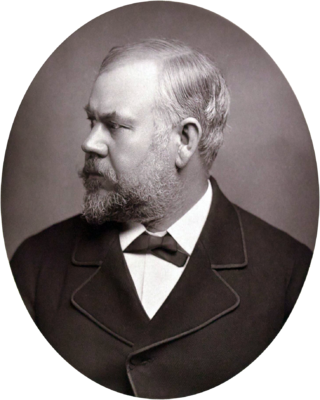
Henry Hugh Armstead was an English sculptor and illustrator, influenced by the Pre-Raphaelites.

The Parthenon frieze is the high-relief Pentelic marble sculpture created to adorn the upper part of the Parthenon's naos.
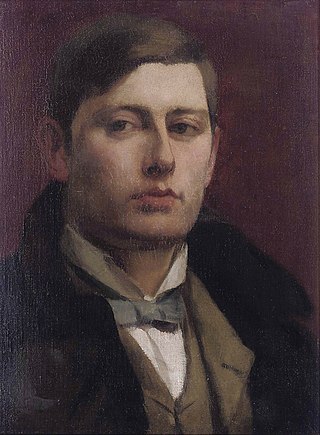
Sir George James Frampton, was a British sculptor. He was a leading member of the New Sculpture movement in his early career when he created sculptures with elements of Art Nouveau and Symbolism, often combining various materials such as marble and bronze in a single piece. While his later works were more traditional in style, Frampton had a prolific career in which he created many notable public monuments, including several statues of Queen Victoria and later, after World War I, a number of war memorials. These included the Edith Cavell Memorial in London, which, along with the Peter Pan statue in Kensington Gardens are possibly Frampton's best known works.
Alan LeQuire is an American sculptor from Nashville, Tennessee. Many of his sculptures are installed in the city.

The Beaux-Arts Institute of Design was an art and architectural school at 304 East 44th Street in Turtle Bay, Manhattan, in New York City. It was founded in 1916 by Lloyd Warren for the training of American architects, sculptors and mural painters consistent with the educational agenda of the French École des Beaux-Arts. The building is now home to Egypt's mission to the United Nations.
John Birnie Philip was a nineteenth-century English sculptor. Much of his work was carried out for the architect Sir George Gilbert Scott.

École des Beaux-Arts refers to a number of influential art schools in France. The term is associated with the Beaux-Arts style in architecture and city planning that thrived in France and other countries during the late nineteenth century and the first quarter of the twentieth century.

Louis Pierre Henriquel-Dupont was a French engraver. His students included Charles Bellay, Jean-Baptiste Danguin, Adrien Didier, Alphonse and Jules François, Adolphe-Joseph Huot, Achille and Jules Jaquet, Jules Gabriel Levasseur, Aristide Louis, Louis Marckl, Isidore-Joseph Rousseaux, Abel Mignon and Charles Albert Waltner.
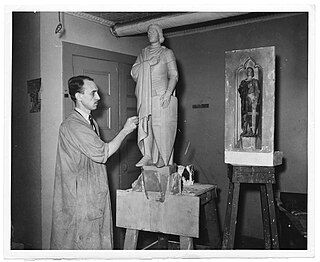
Roy Elwood King was an American born sculptor, painter and civil engineer.
Gilbert William Bayes was an English sculptor. His art works varied in scale from medals to large architectural clocks, monuments and equestrian statues and he was also a designer of some note, creating chess pieces, mirrors and cabinets.
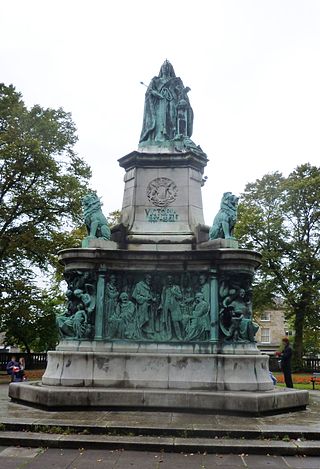
The Queen Victoria Memorial in Lancaster, Lancashire, England, is a Grade II* listed building. It stands in the centre of Dalton Square, Lancaster facing Lancaster Town Hall. It was erected in 1906, being commissioned and paid for by James Williamson, 1st Baron Ashton.
Pierre Lenoir was a French sculptor.
















